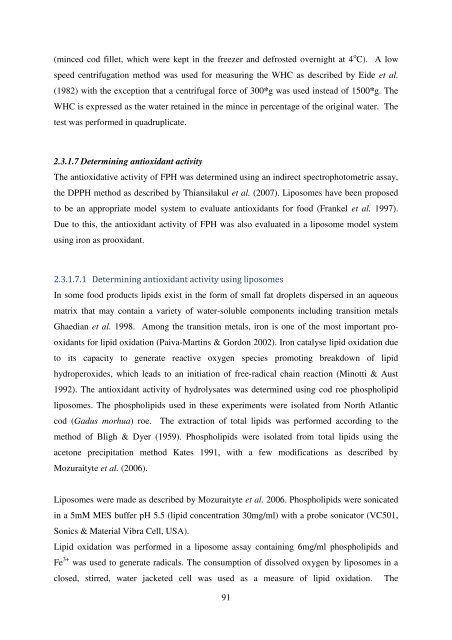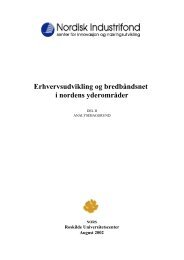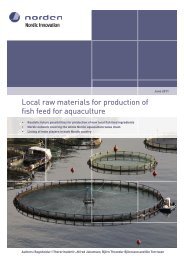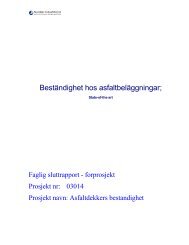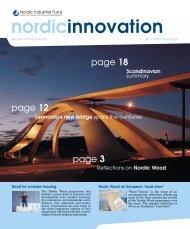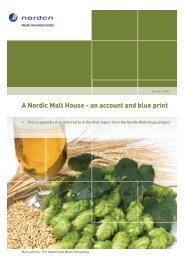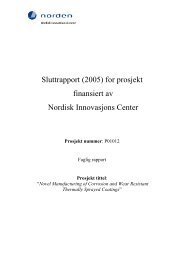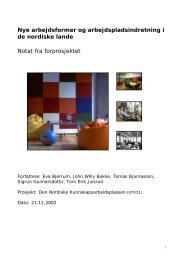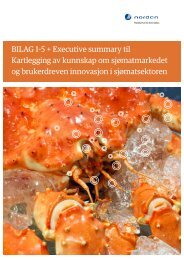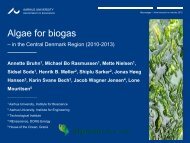Value added fish by-products - Nordic Innovation
Value added fish by-products - Nordic Innovation
Value added fish by-products - Nordic Innovation
Create successful ePaper yourself
Turn your PDF publications into a flip-book with our unique Google optimized e-Paper software.
(minced cod fillet, which were kept in the freezer and defrosted overnight at 4 o C). A low<br />
speed centrifugation method was used for measuring the WHC as described <strong>by</strong> Eide et al.<br />
(1982) with the exception that a centrifugal force of 300*g was used instead of 1500*g. The<br />
WHC is expressed as the water retained in the mince in percentage of the original water. The<br />
test was performed in quadruplicate.<br />
2.3.1.7 Determining antioxidant activity<br />
The antioxidative activity of FPH was determined using an indirect spectrophotometric assay,<br />
the DPPH method as described <strong>by</strong> Thiansilakul et al. (2007). Liposomes have been proposed<br />
to be an appropriate model system to evaluate antioxidants for food (Frankel et al. 1997).<br />
Due to this, the antioxidant activity of FPH was also evaluated in a liposome model system<br />
using iron as prooxidant.<br />
2.3.1.7.1 Determining antioxidant activity using liposomes<br />
In some food <strong>products</strong> lipids exist in the form of small fat droplets dispersed in an aqueous<br />
matrix that may contain a variety of water-soluble components including transition metals<br />
Ghaedian et al. 1998. Among the transition metals, iron is one of the most important pro-<br />
oxidants for lipid oxidation (Paiva-Martins & Gordon 2002). Iron catalyse lipid oxidation due<br />
to its capacity to generate reactive oxygen species promoting breakdown of lipid<br />
hydroperoxides, which leads to an initiation of free-radical chain reaction (Minotti & Aust<br />
1992). The antioxidant activity of hydrolysates was determined using cod roe phospholipid<br />
liposomes. The phospholipids used in these experiments were isolated from North Atlantic<br />
cod (Gadus morhua) roe. The extraction of total lipids was performed according to the<br />
method of Bligh & Dyer (1959). Phospholipids were isolated from total lipids using the<br />
acetone precipitation method Kates 1991, with a few modifications as described <strong>by</strong><br />
Mozuraityte et al. (2006).<br />
Liposomes were made as described <strong>by</strong> Mozuraityte et al. 2006. Phospholipids were sonicated<br />
in a 5mM MES buffer pH 5.5 (lipid concentration 30mg/ml) with a probe sonicator (VC501,<br />
Sonics & Material Vibra Cell, USA).<br />
Lipid oxidation was performed in a liposome assay containing 6mg/ml phospholipids and<br />
Fe 3+ was used to generate radicals. The consumption of dissolved oxygen <strong>by</strong> liposomes in a<br />
closed, stirred, water jacketed cell was used as a measure of lipid oxidation. The<br />
91


